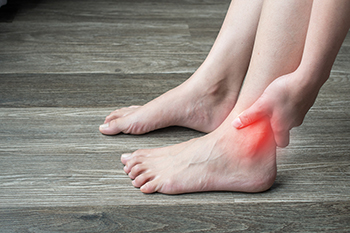Items filtered by date: April 2023
Plantar Fasciitis and Soccer
 Plantar fasciitis is an extremely common affliction of the foot. It affects the plantar fascia, which is the band of tissue that is found along the sole of the foot. Plantar fasciitis may develop when the plantar fascia becomes irritated and inflamed. This painful foot condition can be caused by many sports and strenuous physical activities, such as soccer. Since soccer requires an athlete to engage in frequent sideways and diagonal cuts while running, extra pressure is exerted on the feet. In particular, the medial heel and arch are subject to a significant amount of force in American soccer players. The risk of plantar fasciitis may be even more pronounced in substitute soccer players who, after initially warming up their bodies, wait on the sidelines for long periods of time. This may cause their muscles to tighten up before playing again and can make an individual more susceptible to plantar fasciitis. If you are a soccer player, it is suggested that you contact a podiatrist who will be able to provide you with the treatment for plantar fasciitis.
Plantar fasciitis is an extremely common affliction of the foot. It affects the plantar fascia, which is the band of tissue that is found along the sole of the foot. Plantar fasciitis may develop when the plantar fascia becomes irritated and inflamed. This painful foot condition can be caused by many sports and strenuous physical activities, such as soccer. Since soccer requires an athlete to engage in frequent sideways and diagonal cuts while running, extra pressure is exerted on the feet. In particular, the medial heel and arch are subject to a significant amount of force in American soccer players. The risk of plantar fasciitis may be even more pronounced in substitute soccer players who, after initially warming up their bodies, wait on the sidelines for long periods of time. This may cause their muscles to tighten up before playing again and can make an individual more susceptible to plantar fasciitis. If you are a soccer player, it is suggested that you contact a podiatrist who will be able to provide you with the treatment for plantar fasciitis.
Plantar fasciitis can be very painful and inconvenient. If you are experiencing heel pain or symptoms of plantar fasciitis, contact one of our podiatrists from Florida. Our doctors can provide the care you need to keep you pain-free and on your feet.
What Is Plantar Fasciitis?
Plantar fasciitis is the inflammation of the thick band of tissue that runs along the bottom of your foot, known as the plantar fascia, and causes mild to severe heel pain.
What Causes Plantar Fasciitis?
- Excessive running
- Non-supportive shoes
- Overpronation
- Repeated stretching and tearing of the plantar fascia
How Can It Be Treated?
- Conservative measures – anti-inflammatories, ice packs, stretching exercises, physical therapy, orthotic devices
- Shockwave therapy – sound waves are sent to the affected area to facilitate healing and are usually used for chronic cases of plantar fasciitis
- Surgery – usually only used as a last resort when all else fails. The plantar fascia can be surgically detached from the heel
While very treatable, plantar fasciitis is definitely not something that should be ignored. Especially in severe cases, speaking to your doctor right away is highly recommended to avoid complications and severe heel pain. Your podiatrist can work with you to provide the appropriate treatment options tailored to your condition.
If you have any questions, please feel free to contact our offices located in North Miami, and Pembroke Pines, FL . We offer the newest diagnostic and treatment technologies for all your foot care needs.
Ankle Pain May Happen Without an Injury

Ankle pain is possible to have when there is no obvious injury that has occurred. It may be the result of an autoimmune disease, such as lupus, or from various types of arthritis. These can include gout, reactive arthritis, and rheumatoid arthritis. Some people can experience ankle pain from having flat feet and Achilles tendonitis, which may happen gradually from wear and tear of the Achilles tendon. Some people may have ankle pain from an existing infection, such as streptococcus, which can affect the ankle bone and surrounding joints. An examination is often performed to determine the cause of the ankle pain. This is done by having an ultrasound or CT scan, which are successful methods for viewing joint or bone damage. If you have ankle pain for any reason, it is suggested that you consult with a podiatrist who can offer you the correct treatment solutions.
Ankle pain can have many different causes and the pain may potentially be serious. If you have ankle pain, consult with one of our podiatrists from Florida. Our doctors will assess your condition and provide you with quality foot and ankle treatment.
Ankle pain is any condition that causes pain in the ankle. Due to the fact that the ankle consists of tendons, muscles, bones, and ligaments, ankle pain can come from a number of different conditions.
Causes
The most common causes of ankle pain include:
- Types of arthritis (rheumatoid, osteoarthritis, and gout)
- Ankle sprains
- Broken ankles
- Achilles tendinitis
- Achilles tendon rupture
- Stress fractures
- Tarsal tunnel syndrome
- Plantar fasciitis
Symptoms
Symptoms of ankle injury vary based upon the condition. Pain may include general pain and discomfort, swelling, aching, redness, bruising, burning or stabbing sensations, and/or loss of sensation.
Diagnosis
Due to the wide variety of potential causes of ankle pain, podiatrists will utilize a number of different methods to properly diagnose ankle pain. This can include asking for personal and family medical histories and of any recent injuries. Further diagnosis may include sensation tests, a physical examination, and potentially x-rays or other imaging tests.
Treatment
Just as the range of causes varies widely, so do treatments. Some more common treatments are rest, ice packs, keeping pressure off the foot, orthotics and braces, medication for inflammation and pain, and surgery.
If you have any questions, please feel free to contact our offices located in North Miami, and Pembroke Pines, FL . We offer the newest diagnostic and treatment technologies for all your foot care needs.
